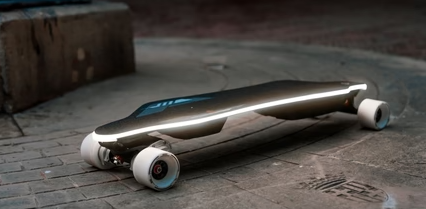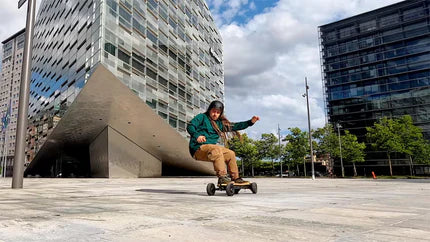Electric skateboards aren't just for kids these days; adults are hopping on them for commuting, having fun, and even doing tricks. As more people get into electric skateboards, a question often comes up: Do you have to know how to ride a regular skateboard before you try an electric one? In this post, we're going to explore that question and check out the differences between electric and traditional skateboards. Also, we'll talk about the pros and cons of starting with an electric board, and how skills can transfer between the two.
Electric vs. Traditional Skateboards: What's the Difference?
What Are the Key Features of Traditional Skateboards?
- Regular skateboards need you to push off the ground to get moving. Riders kick off the ground to gain speed, using their legs to for power.
- There are all sorts of skateboards, from short cruisers to longboards, and each one suits different styles and terrains.
- A traditional skateboard has a few key parts. First, there's the deck, which is the board where you stand. Then, you have the trucks, the metal pieces that connect the wheels to the deck and help with turning. The wheels come in different sizes and hardness, which will affect the riding quality and speed. Lastly, there are the bearings— they let the wheels spin smoothly and impact how well the skateboard performs.
What Makes Electric Skateboards Unique?
- Electric skateboards really make it easy by removing the need for all that manual effort. They have a motor that helps you move forward, so you can go faster without having to push off.
- A lot of electric skateboards come with remote controls that let riders speed up and brake smoothly. This tech makes electric skateboards more accessible for folks who lack the physical strength or balance needed for regular skateboarding.
- The battery life of electric skateboards varies quite a bit, usually from a few miles to more than 30 miles on a single charge, depending on the specific model you choose. Riders need to be aware of your battery levels and charging times, as no one wants to end up stranded while cruising on your electric skateboard.
How Their Riding Experiences Different
The experience of riding an electric skateboard differs significantly from that of a traditional skateboard.
- With traditional boards, you have to master balance and maneuvering through pushing and carving.
- On an electric skateboard, while you still need some balance, much of the focus shifts to learning how to control speed and stop effectively.
As a result, the learning curve can feel different; some find electric skateboards easier to pick up, while others argue that understanding the basics of skating gives you an edge.

Can You Begin with an Electric Skateboard?
Absolutely, you can start riding an electric skateboard even if you've never done it before. They make it easier to control and take less physical effort, which is great for beginners. But you know, having some basic skateboarding skills really can make your riding experience more enjoyable and safer.
Advantages of Starting with an E-Skateboard
- Less Physical Effort Required: Electric skateboards are easier to ride than traditional ones because you don't have to push off the ground constantly. They let you cruise with minimal effort, making them great for those who aren't very active or are new to skating. You can enjoy the ride without getting tired!
- Lower Risk of Falls Due to Stability and Control Features: Electric skateboards are generally more stable and easier to control. Many models have wider decks and larger, softer wheels that help beginners balance better. The remote control allows for smoother speed adjustments, which reduces the chance of sudden movements that might lead to falls.

Potential Drawbacks of Starting with an E-Skateboard
If you decide to start with an e-skateboard, it's essential to consider some potential drawbacks to starting with an electric skateboard.
- More Reliable on Technology: Because electric skateboards do much of the work for you, beginners might miss out on mastering essential skateboarding skills like pushing, braking, and turning. If you decide to transition to a traditional skateboard later on, you might find yourself struggling with these fundamental techniques.
- Limited Experience in Fundamental Skateboarding Maneuvers: Starting with an electric skateboard could also limit your experience with basic maneuvers. For example, you might not learn how to carve properly, perform tricks, or handle difficult terrain if you skip the foundational skills that traditional skateboarding teaches— not that convenient if you ever want to try more advanced skating styles.
Safety Tips for Newbies to Begin with E-Skateboards
If you're looking forward to trying out an electric skateboard, here are a few safety tips to help you get started smoothly:
- Put on Protective Gear: Make sure to wear a helmet and knee and elbow pads for extra safety. Since you're new to riding, safety should always come first.
- Pick the Right Spot: Begin your practice in a flat, open space that's clear of traffic and any obstacles. This will let you concentrate on getting used to your board without stressing about other dangers.
- Take It Easy: Don't rush into high speeds. Begin at a relaxed pace to boost your confidence and understand how the skateboard reacts to your movements.
- Get to Know the Remote: Take some time to be familiar with the remote control before you head out. Getting the hang of accelerating and braking properly can help you feel more confident and safe on the road.
How to Transfer Skills from Regular Skateboarding to Electric Skateboarding
If you already have some experience with traditional skateboarding, you'll find that many skills transfer nicely to electric skateboarding.

Balance and Stance
If you've skated before, you'll notice that your muscle memory comes into play. Keeping your body in the right position is key to staying balanced on the board, whether you're using your own strength or a motor to get around.
Spatial Awareness and Navigation
Navigating your surroundings is another vital skill that transfers well. It's really important to know how to observe and react to obstacles, like bumps in the road or people walking by. Being able to gauge distances and adjust your route remains helpful when you switch to an electric board.
Turning and Carving
Electric skateboards are generally heavier, so turning might feel different. Use your experience with carving on a traditional skateboard but apply it more gradually to accommodate the added weight and motor responsiveness.
Building Upon Foundational Skills
If you already know how to ride a traditional skateboard, here's how you can build upon those skills:
- Speed Control: Electric skateboards have remote controls for speed, so you'll need to get comfortable using your hand to adjust speed rather than relying on pushing. Start at lower speeds to familiarize yourself with braking and accelerating smoothly.
- Braking Techniques: Unlike regular skateboards where you use your foot to brake, electric skateboards have electronic brakes. Practicing braking gently with the remote helps you get used to deceleration at different speeds.
- Handling Terrain: Electric skateboards manage rough terrain differently. Gradually practice riding over bumps or inclines to gauge how the motor reacts, adjusting your balance and stance to handle uneven surfaces.
Experience the Freedom of e-Skateboarding
So, you don't have to learn to ride a regular skateboard before jumping on an electric one, but having that experience can definitely make your ride even better. Electric skateboards are a great way for beginners to explore skating without having to deal with the tough learning curve that comes with traditional boards. And knowing the differences, benefits, and possible downsides can prepare you for a more fulfilling ride. Grab a board, put on your safety gear, and get ready to hit the road— your adventure awaits!


